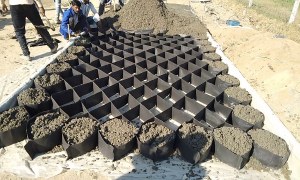🕑 Reading time: 1 minute
Properties of Hardened Concrete
Fully cured, hardened concrete must be strong enough to withstand the structural and service loads which will be applied to it and must be durable enough to withstand the environmental exposure for which it is intended. When concrete is made with high-quality materials and is properly proportioned, mixed, handled, placed, and finished, it is one of the strongest and most durable of building materials. When we refer to concrete strength, we are generally talking about compressive strength which is measured in pounds per square inch (psi). Concrete is strong in compression but relatively weak in tension and bending. It takes a great deal of force to crush concrete, but very little force to pull it apart or cause bending cracks (Figure 1). Compressive strength is determined primarily by the amount of cement used but is also affected by the ratio of water to cement, as well as proper mixing, placing, and curing. Tensile strength usually ranges from 7 or 8% of compressive strength in high-strength mixes to 11 or 12% in low-strength mixes. Both tensile strength and flexural bending strength can be increased by adding steel or fiber reinforcement. Structural engineers establish required compressive strengths for various building elements based on an analysis of the loads which will be applied and the soil conditions at the project site. Actual compressive strength is verified by testing samples in a laboratory using standardized equipment and procedures.
On commercial projects, numerous samples are tested throughout construction to verify that the concrete being put into place actually has the specified strength.
Laboratory testing is not often required in residential work, except perhaps on large, high-end projects or on projects with difficult sites where special foundation designs make concrete strength critical.
For most residential projects, required concrete strength will be in the range of 20 MPa to 30 MPa, depending on the intended use (Table below). A concrete that is stronger than necessary for its intended use is not economical, and one that is not strong enough can be dangerous.
The primary factors affecting concrete compressive strength are the cement content, the ratio of water to cement, and the adequacy and extent of hydration and curing.
Structural engineers establish required compressive strengths for various building elements based on an analysis of the loads which will be applied and the soil conditions at the project site. Actual compressive strength is verified by testing samples in a laboratory using standardized equipment and procedures.
On commercial projects, numerous samples are tested throughout construction to verify that the concrete being put into place actually has the specified strength.
Laboratory testing is not often required in residential work, except perhaps on large, high-end projects or on projects with difficult sites where special foundation designs make concrete strength critical.
For most residential projects, required concrete strength will be in the range of 20 MPa to 30 MPa, depending on the intended use (Table below). A concrete that is stronger than necessary for its intended use is not economical, and one that is not strong enough can be dangerous.
The primary factors affecting concrete compressive strength are the cement content, the ratio of water to cement, and the adequacy and extent of hydration and curing.
| Construction element | Compressive strength Mpa |
| Basement and foundation walls slabs | 20 t0 25 |
| Driveways, garage slab | 20 t0 25 |
| Reinforced concrete beams, slabs, patios, sidewalks and steps | 20 to 25 |


